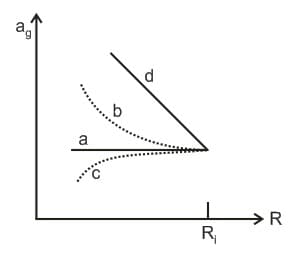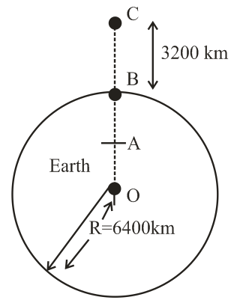Acceleration Due To Gravity
Acceleration Due To Gravity: Overview
This topic covers concepts, such as, Gravitational Force Between Spherical Shell and Point Mass Kept Outside, Acceleration Due to Gravity, Variation in g Due to Shape of Earth & Variation in g Due to Rotation of Earth etc.
Important Questions on Acceleration Due To Gravity
In older times, people used to think that the Earth was flat. Imagine that the Earth is indeed not a sphere of radius , but an infinite plate of thickness . What value of is needed to allow the same gravitational acceleration to be experienced as on the surface of the actual Earth? (Assume that the Earth's density is uniform and equal in the two models).
A (nonrotating) star collapses onto itself from an initial radius with its mass remaining unchanged. Which curve in figure best gives the gravitational acceleration on the surface of the star as a function of the radius of the star during the collapse?

If a tunnel is cut at any orientation through the earth, then a ball released from one end will reach the other end in how much time (neglect earth rotation)?
A spherical uniform planet is rotating about its axis. The velocity of a point on its equator is . Due to the rotation of the planet about its axis the acceleration due to gravity at equator is of at poles. The escape velocity of a particle on the planet in terms of from the pole of the planet is,
The mass and diameter of a planet are twice those of earth. What will be the period of oscillation of a pendulum on this planet if it is a second pendulum on earth?
If the radius of the earth be increased by a factor of 5, by what factor its density be changed to keep the value of g same?
Let be the angular velocity of the earth's rotation about its axis. Assume that the acceleration due to gravity on the earth's surface has the same value at the equator and the poles. An object weighed at the equator gives the same reading as a reading taken at a depth below earth's surface at a pole . The value of is:
Gravitational force on point mass in side solid sphere.
(i) When a point mass is considered at distance from the centre of solid sphere inside it then gravitational force on point mass is proportional to.
If the radius of the earth were to shrink by one percent, its mass remaining same, the value of on the earths surface would
Weight of an object can be explained as
The ratio of the acceleration due to gravity on two planets and is . The ratio of their respective radii is . The ratio of their respective escape velocities is
is the radius of Earth and is its angular velocity and is the value of at the poles. The effective value of at a latitude
Suppose that the angular velocity of rotation of the Earth is increased. Then, as a consequence,
The mass density of a spherical body is given by for and for where is the distance from the centre. The correct graph that describes qualitatively the acceleration, of a test particle as a function of is :
The mass density of a spherical body is given by for and for where is the distance from the centre. The correct graph that describes qualitatively the acceleration, of a test particle as a function of is :
In the reported figure of earth, the value of acceleration due to gravity is same at point and but it is smaller than that of its value at point (surface of the earth). The value of OA : AB will be The value of is ___________ .

At a height of above the surface of earth, the value of acceleration due to gravity is the same as that of a particular depth below the surface of earth. Assuming uniform mass density of the earth, the depth is,
What happens to the acceleration due to gravity with the increase in altitude from the surface of the earth?
The gravitational field due to a mass distribution is, in the -direction ( is a constant). Taking the gravitational potential to be zero at infinity, its value at a distance is,
A spiral galaxy can be approximated as an infinitesimally thin disc of a uniform surface mass density (mass per unit area) located at Two stars and start from rest from heights and ( radial extent of the disc), respectively and fall towards the disc, cross over to the other side and execute periodic oscillations. The ratio of time periods of and is
